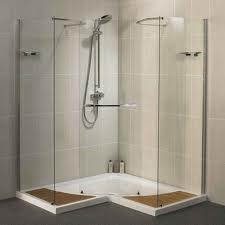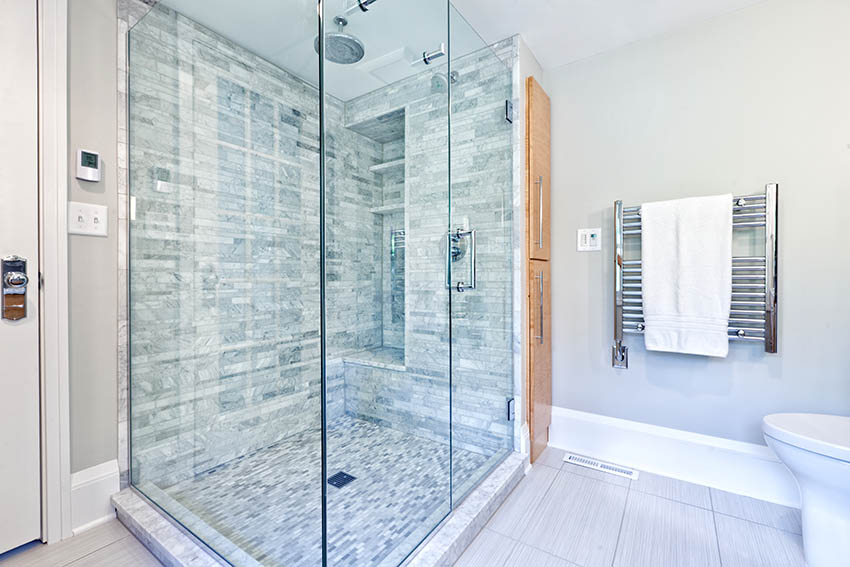We have discovered this article involving How to Install a Shower Enclosure below on the net and thought it made perfect sense to relate it with you on this page.

A successful shower installment calls for cautious planning and a great deal of work. In many cases, you will require to do three types of jobs: mounting walls, installing the plumbing, and also completing walls.
Various Kinds Of Shower Units
- Push-on Mixer: The hose pipe and also spray parts of the push-on mixer shower system can be connected to the bathroom faucet as per your requirement, and also the water temperature can be readjusted by means of the taps. Push-on mixers are cheap and also very simple to set up. However, although the tube connection is simple, it is conveniently removed. In addition, it is troublesome to adjust the temperature level.
- Bath/Shower Mixer: The hose pipe and also spray of this kind of shower are combined with a bathroom mixer tap, and also the temperature can be readjusted through the bathroom taps. It is a really low-cost option as well as no extra plumbing is included. However, the bath/shower mixers likewise suffer from bothersome temperature control choices.
- Manual Mixer: The pipe and spray of a hands-on mixer shower device are a part of the wall surface unit and also the hot and cold water materials are attached to a single shutoff The temperature and pressure of the water are regulated through either one or a selection of knobs (in a lot more pricey showers). Although temperature control is a lot easier in hand-operated mixer types, they are a lot more expensive than the previously stated mixers. They also need added plumbing of hot and cold water system pipelines.
- Thermostatic Mixer: The hose as well as spray of this shower kind are a part of the wall system and also the hot and cold water supplies are linked to a solitary shutoff here as well. It is full with a built-in stabiliser to self-adjust the water temperature as well as to stop it from becoming too warm. Among the biggest advantages of a thermostatic mixer shower type includes practical temperature level control. However, it is the most costly of the various mixer alternatives.
- Power Shower: A power shower is a solitary unit including a powerful electrical pump that can modifying both the water pressure and temperature. This kind of shower can be fitted if there is water system from a cold water tank and also a hot water cylinder. A power shower makes the adjustment of both pressure as well as temperature level simple. On the other hand, it disagrees for water warmed straight by the shower or where the water is provided by a combination boiler under mains pressure.
- Electric Shower: An electric shower is plumbed into a mains cold water supply as well as it heats up the water electrically. It is very important to keep in mind that for this shower kind to be set up, the keys pressure needs to be at least 0.7 kg/sq cm (10lb/sq in). The unit allows the temperature and pressure to be adjusted via a knob. Models with temperature level stabilisers are much better as they continue to be unaffected by other taps elsewhere in use within the household. A significant downside of electrical showers is that the control handle just enables the choice of high temperatures at less pressure, or lower temperatures at a better stress. This is bothersome in the winter when the spray is typically weak as well as the mains water is colder. However, this trouble is taken on in some designs which are offered with a winter/summer setting.
The Majority Of Usual Errors
- Breaking or disregarding local code constraints.
- Making use of pipelines that are too small.
- Affixing copper to galvanized without making use of a brass or dielectric fitting between both.
- Not making use of tape or pipe compound at threaded joints.
- Uneven your components when installing them.
- Not installing an air void filling up for fixtures.
- Cutting supply stub outs also short to install the shutoff valves onto after the ended up wall surface is in place.
- Not effectively lining up tubing right into installations or stop shutoffs. (Requiring the nut onto the compression ring at an angle when the tubing goes to an angle will cause a leakage.).
- When turning the water back on in your home, constantly run the outside hose shutoff or flush your commodes to hemorrhage dirt and also air from the lines. This debris can cause issues in your sink faucets and also various other plumbing trim.
Preparation.
To start with, you should decide on the kind of shower that you wish to mount. It is essential to ascertain whether the selected shower is capable of managing specific systems and also can control a safe degree of water through the central heating boiler. Most shower devices nowadays are designed to be adaptable to different water stress (such as stored warm water and chilly mains).
It is likewise important to consider the water stress and the preparation of the piping and drain for the shower.
Approach.
Depending upon the sort of shower you wish to mount, the shower head must either be suited order to avoid its contact with the water in the bathroom below or the base tray, or it needs to have a check valve.
Before beginning, it is advisable to note the placements of the shower head and control, and also to plan the pipe-work included. In addition, the drainage system to eliminate the drainage will require to be intended. Both positions of the cord course and the shower button will certainly also need to be taken into consideration if an instantaneous or electric shower system is being set up.
Make use of the guideline overview offered with the shower system to fit the shower control.Before suitable the pipelines that will supply the water to the shower system, it is essential to remove the water. In order to protect the pipes, they must be offered a waterproof covering and likewise fitted with separating shutoffs. The pipelines can then be buried into the wall surface and also smudged over to neaten the overall look.
Fit the base tray, shower head, as well as fittings.
Link the major shower control to the pipelines that will certainly be supplying the water (This may require a female screw string adapter).
Reconnect the water system and also examination the pipelines for any leaks, as some may need tightening up.
If you are setting up an electric shower, bear in mind to turn off the power supply before making any electrical connections. When these connections have been made (there must be support within the user's manual), the power supply can be changed back on.
Readjusting Water Stress to Match Your Shower.
The cold water storage tank can be raised to a better elevation (often as low as 150mm (6inches)) by installation a strong wooden support below it - possibly composed of struts and blockboards. If you choose this option, the main and also circulation pipelines will certainly likewise need to be increased to satisfy the new height of the reservoir.
Conversely, a booster pump (a solitary pump or a dual/twin pump) can be fitted. Whichever kind is selected, it needs to be linked into the power supply in order to operate.
Piping and also Water drainage.
It is best to make use of 15mm size supply pipes, and make the runs to the shower as brief and also straight as feasible so as to maintain optimal stress as well as minimise heat loss. Additionally, by reducing using arm joints for pipe corners, you can lower the resistance in the circulation of the supply of water. You can achieve this by flexing the pipelines instead.
How Do You Install a Shower? Follow This Guide
Installing a Shower at a Glance
- Tools & Materials: Level, electric drill, caulk, hole saw, cedar shims, shower unit
- Step 1: Drill pilot holes
- Step 2: Prep fixture holes
- Step 3: Move unit into place
- Step 4: Caulk corners and base
- Step 5: Attach door
- Step 6: Install shower pan
Whenever plumbing is involved in a DIY project, people worry about what might go wrong. The truth is that installing a shower isn’t that complicated, and you can save a lot of money by doing it yourself. You shouldn’t need to make any alterations to your plumbing to complete the job, and most of the tools you need will be provided in your new shower kit.
Can I Install a Shower Myself?
Even if you’ve never installed a shower before, you’ll find this to be a project that is perfectly suited for DIYers with a moderate level of experience. Whether you're doing a bathtub conversion or installing a new stall, most of what you need comes in shower kits that you can purchase from a hardware store. The first thing you need to do is determine what type of shower stall you want.
Single-panel stalls are the easiest to install because they come preassembled. All you need to do is put them in place. Multi-panel showers require a few additional steps, but you’ve got more control over the appearance of your unit. Multi-panel units are also much easier to handle if you’re going to do the installation without any help.
Be sure to take all appropriate safety precautions, such as wearing eye protection and gloves. When you’re removing or installing a shower unit, you might kick up debris that could hurt your eyes. You’ll also need to work with equipment that will get extremely hot, so be sure to have safety gloves handy.
Tools and Materials
- 2- to 4-foot level
- Electric drill with a 1/8-inch drill bit
- Caulk
- 2-inch hole saw
- Cedar shims
- The unit itself
Before You Begin: Prep the Space
It’s highly important to measure your space accurately before putting the stall in. Measuring from the floor upward and from each corner outward will ensure you’ve got the right measurements. What you’re looking for is where the plumbing apparatuses are going to come through the stall. Transfer these measurements over to the back of your unit by drawing the locations of these holes using a pencil or marker.
Pull out your old shower and make sure to scrape off all the old caulking. Be thorough because you want to work with smooth surfaces for the best installation. Once you’ve pulled out your existing shower, you need to make sure that the floor is clean and dry. The best way to clean debris is with a shop vacuum, as it’ll soak up water and dirt together.
If you’re experiencing any plumbing issues, such as low water pressure, this is a perfect opportunity to solve them. Make sure that the pipes themselves are not in need of patching and clean your showerhead. When you turn the water back on after your project, check the pipes for signs of wear or disrepair. Anything beyond minor repairs should be handled by a plumber, and this is the best time to bring in a professional.
If the floor has any moisture at all, don’t proceed until it’s completely dry. The last thing you need is for the floor to rot or invite mold and mildew into your base. Once everything is dry, apply waterproof wallboard to the walls. This can be attached with screws or nails, then sealed with caulk so that water doesn’t seep into any crevices.

I found that post on How to Build a Shower Enclosure for Your DIY Bathroom while browsing on the internet. Sharing is caring. You won't know, you could be helping someone out. Thank you so much for going through it.
Book A Service
Comments on “Building A Superior Bathroom - How To Install A New Shower Unit”